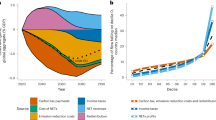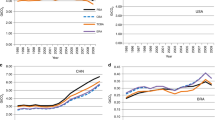Abstract
Assessments of emissions mitigation patterns have largely ignored the huge variation in real-world factors—in particular, institutions—that affect where, how and at what costs firms deploy capital1,2,3,4,5. We investigate one such factor—how national institutions affect investment risks and thus the cost of financing6,7,8. We use an integrated assessment model (IAM; ref. 9) to represent the variation in investment risks across technologies and regions in the electricity generation sector—a pivotally important sector in most assessments of climate change mitigation10—and compute the impact on the magnitude and distribution of mitigation costs. This modified representation of investment risks has two major effects. First, achieving an emissions mitigation goal is more expensive than it would be in a world with uniform investment risks. Second, industrialized countries mitigate more, and developing countries mitigate less. Here, we introduce a new front in the research on how real-world factors influence climate mitigation. We also suggest that institutional reforms aimed at lowering investment risks could be an important element of cost-effective climate mitigation strategies.
This is a preview of subscription content, access via your institution
Access options
Subscribe to this journal
Receive 12 print issues and online access
$209.00 per year
only $17.42 per issue
Buy this article
- Purchase on Springer Link
- Instant access to full article PDF
Prices may be subject to local taxes which are calculated during checkout




Similar content being viewed by others
References
Clarke, L. et al. International climate policy architectures: Overview of the EMF 22 International Scenarios. Energy Econ. 31, S64–S81 (2009).
McCollum, D. et al. Energy investments under climate policy: A comparison of global models. Clim. Change Econ. 4, 1340010 (2013).
Kriegler, E. et al. The role of technology for achieving climate policy objectives: Overview of the EMF 27 study on global technology and climate policy strategies. Climatic Change 123, 353–367 (2014).
Riahi, K. et al. Locked into Copenhagen pledges—Implications of short-term emission targets for the cost and feasibility of long-term climate goals. Technol. Forecast. Soc. Change 90, 8–23 (2015).
Calvin, K. et al. The role of Asia in mitigating climate change: Results from the Asia modeling exercise. Energy Econ. 34, S251–S260 (2012).
North, D. C. Institutions, Institutional Change and Economic Performance (Cambridge Univ. Press, 1990).
Faria, A. & Mauro, P. Institutions and the external capital structure of countries. J. Int. Money Finance 28, 367–391 (2009).
Acemoglu, D. & Zilibotti, F. Was Prometheus unbound by chance? Risk, diversification, and growth. J. Polit. Econ. 105, 709–751 (1997).
Kim, S., Edmonds, J., Lurz, J., Smith, S. & Wise, M. The ObjECTS framework for integrated assessment: Hybrid modeling of transporation. Energy J. 27, 63–91 (2006).
Clarke, L. et al. in Climate Change 2014: Mitigation of Climate Change (eds Edenhofer, O. et al.) Ch. 6 (IPCC, Cambridge Univ. Press, 2014).
Schwab, K. Global Competitiveness Report (World Economic Forum, 2013).
GCAM-wiki; http://wiki.umd.edu/gcam/index.php?title=Main_Page
IPCC Climate Change 2014: Mitigation of Climate Change (eds Edenhofer, O. et al.) (2014).
Tavoni, M., De Cian, E., Luderer, G., Steckel, J. C. & Waisman, H. The value of technology and of its evolution towards a low carbon economy. Climatic Change 114, 39–57 (2012).
Iyer, G. et al. Diffusion of low-carbon technologies and the feasibility of long-term climate targets. Technol. Forecast. Soc. Change 90, 103–118 (2015).
Calvin, K. et al. The distribution and magnitude of emissions mitigation costs in climate stabilization under less than perfect international cooperation: SGM results. Energy Econ. 31, S187–S197 (2009).
Guivarch, C., Crassous, R., Sassi, O. & Hallegatte, S. The costs of climate policies in a second-best world with labour market imperfections. Clim. Policy 11, 768–788 (2011).
Jakob, M., Luderer, G., Steckel, J., Tavoni, M. & Monjon, S. Time to act now? Assessing the costs of delaying climate measures and benefits of early action. Climatic Change 114, 79–99 (2012).
Chaturvedi, V., Clarke, L., Edmonds, J., Calvin, K. & Kyle, P. Capital investment requirements for greenhouse gas emissions mitigation in power generation on near term to century time scales and global to regional spatial scales. Energy Econ. 46, 267–278 (2014).
Clarke, L., Calvin, K., Edmonds, J., Kyle, P. & Wise, M. in Post-Kyoto International Climate Policy: Implementing Architectures for Agreement (eds Aldy, J. E. & Stavins, R. N.) Ch. 25 (IPCC, Cambridge Univ. Press, 2010).
Clarke, J. F. & Edmonds, J. Modelling energy technologies in a competitive market. 15, 123–129 (1993).
McFadden, D. Econometric models for probabilistic choice among products. J. Bus. 53, S13–S29 (1980).
Train, K. Qualitative Choice Analysis: Theory, Econometrics, and an Application to Automobile Demand (MIT Press, 1993).
Short, W., Packey, D. J. & Holt, T. A Manual for the Economic Evaluation of Energy Efficiency and Renewable Energy Technologies (National Renewable Energy Laboratory, 1995).
Den Elzen, M. G. J., Höhne, N., Hagemann, M. M., van Vliet, J. & van Vuuren, D. P. Sharing developed countries’ post-2012 greenhouse gas emission reductions based on comparable efforts. Mitig. Adapt. Strateg. Glob. Change 15, 433–465 (2010).
North, D. C. in Handbook of New Institutional Economics (eds Ménard, C. & Shirley, M. M.) 21–30 (Springer, 2008).
Carraro, C., Favero, A. & Massetti, E. Investments and public finance in a green, low carbon, economy. Energy Econ. 34, S15–S28 (2012).
Acknowledgements
Research support for G.C.I., L.E.C., J.A.E. and H.C.M. was provided by the Global Technology Strategy Program. N.E.H. was supported by the National Science Foundation under grant number 1056998. D.G.V. was supported by the Electric Power Research Institute, BP Plc and the Norwegian Research Foundation. This research used Evergreen computing resources at the Pacific Northwest National Laboratory’s (PNNL) Joint Global Change Research Institute at the University of Maryland in College Park. PNNL is operated for DOE by Battelle Memorial Institute under contract DE-AC05-76RL01830. The views and opinions expressed in this article are those of the authors and do not necessarily reflect the official policy or position of any agency of the United States.
Author information
Authors and Affiliations
Contributions
All authors jointly designed the experiments and analysed the results. G.C.I. conducted the experiments and wrote the first draft of the paper. All authors contributed to writing the paper.
Corresponding author
Ethics declarations
Competing interests
The authors declare no competing financial interests.
Supplementary information
Rights and permissions
About this article
Cite this article
Iyer, G., Clarke, L., Edmonds, J. et al. Improved representation of investment decisions in assessments of CO2 mitigation. Nature Clim Change 5, 436–440 (2015). https://doi.org/10.1038/nclimate2553
Received:
Accepted:
Published:
Issue Date:
DOI: https://doi.org/10.1038/nclimate2553
This article is cited by
-
Distributional labour challenges and opportunities for decarbonizing the US power system
Nature Climate Change (2023)
-
Energy transition in Southeast Asian countries: is there a role for governance at country level?
Environmental Science and Pollution Research (2023)
-
Plant conversions and abatement technologies cannot prevent stranding of power plant assets in 2 °C scenarios
Nature Communications (2022)
-
Ratcheting of climate pledges needed to limit peak global warming
Nature Climate Change (2022)
-
Capital markets and the costs of climate policies
Environmental Economics and Policy Studies (2022)



